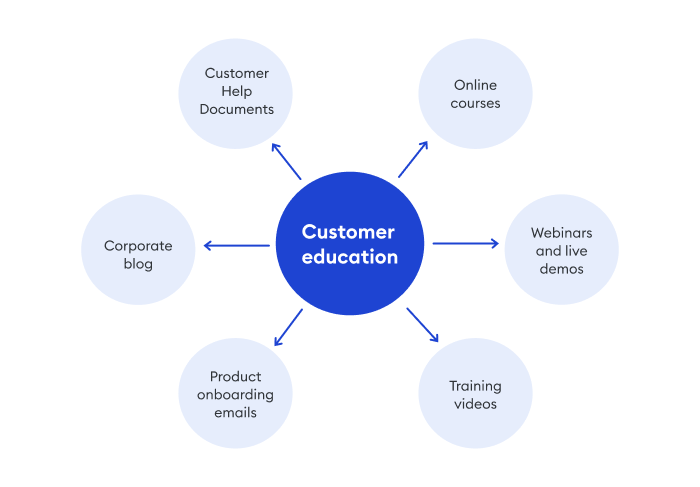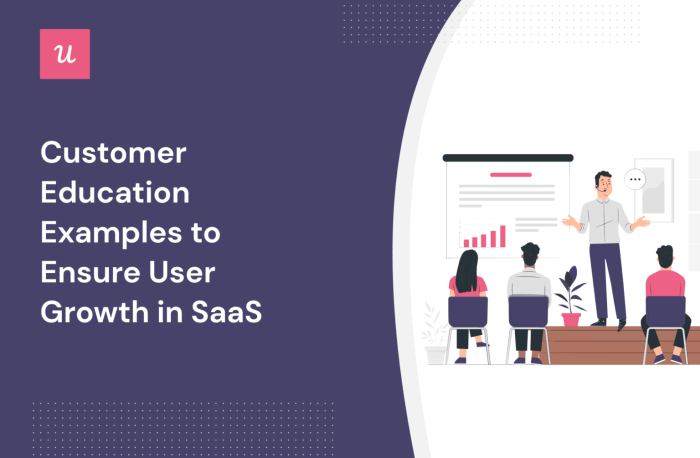With Using Content for Customer Education at the forefront, this paragraph opens a window to an amazing start and intrigue, inviting readers to embark on a storytelling american high school hip style filled with unexpected twists and insights.
Customer education plays a pivotal role in businesses today, shaping customer satisfaction and loyalty through informative and engaging content. By exploring the power of content in educating customers, businesses can create lasting connections and drive success in a competitive market.
Importance of Customer Education
Customer education is crucial for businesses as it helps in building strong relationships with customers, enhancing their overall experience, and increasing brand loyalty. By providing valuable information and guidance to customers, businesses can empower them to make informed decisions and maximize the benefits of their products or services.
Enhancing Customer Satisfaction and Loyalty
Customer education can enhance customer satisfaction and loyalty by ensuring that customers fully understand how to use a product or service effectively. For example, a software company that provides detailed tutorials and guides can help customers navigate the software more efficiently, leading to a better user experience and ultimately increasing customer satisfaction and loyalty.
Benefits of Investing in Customer Education Initiatives
Investing in customer education initiatives can yield various benefits for businesses, such as reducing customer support costs by empowering customers to troubleshoot common issues on their own. Additionally, educated customers are more likely to become brand advocates, spreading positive word-of-mouth and attracting new customers. Overall, customer education plays a vital role in building long-term relationships with customers and driving business growth.
Types of Content for Customer Education: Using Content For Customer Education

When it comes to educating customers, there are various forms of content that can be used to effectively convey information and engage the audience. From blog posts to videos, webinars, infographics, quizzes, and tutorials, each type of content serves a unique purpose in educating customers and enhancing their overall experience.
Blog Posts, Using Content for Customer Education
- Blog posts are a great way to provide detailed information on a specific topic or product.
- They can be used to answer common customer questions, address concerns, and showcase new features or updates.
- By regularly posting relevant and informative content, businesses can establish themselves as industry experts and build trust with their customers.
Videos
- Videos are highly engaging and can effectively demonstrate product features, usage instructions, and troubleshooting tips.
- They are perfect for visual learners and can help simplify complex concepts for customers.
- Businesses can use videos to create tutorials, product reviews, customer testimonials, and behind-the-scenes glimpses to educate and entertain their audience.
Webinars
- Webinars provide a live interactive platform for businesses to engage with their customers in real-time.
- They allow for in-depth discussions, Q&A sessions, and product demonstrations that can address specific customer concerns and provide valuable insights.
- By hosting webinars, businesses can establish a direct line of communication with their customers and showcase their expertise and commitment to customer education.
Infographics
- Infographics are visually appealing and can effectively convey complex information in a simple and easy-to-understand format.
- They are perfect for summarizing key points, statistics, and data in a visually engaging manner.
- Businesses can use infographics to present product comparisons, industry trends, and step-by-step guides to educate and inform their customers effectively.
Interactive Content
- Interactive content such as quizzes and tutorials can aid in educating customers by providing hands-on learning experiences.
- Quizzes can help assess customer knowledge, reinforce key concepts, and make the learning process fun and engaging.
- Tutorials offer step-by-step instructions, practical tips, and interactive elements that allow customers to learn at their own pace and test their understanding.
Personalized Content
- Personalized content is tailored to the individual preferences, interests, and needs of customers.
- By creating personalized content, businesses can deliver relevant information, recommendations, and solutions that resonate with each customer.
- Personalization can enhance the customer experience, increase engagement, and build loyalty by showing customers that their unique needs are understood and valued.
Strategies for Creating Educational Content
To effectively educate customers through content, it is essential to have a well-thought-out strategy in place. Tailoring content to different customer segments or personas and creating engaging and informative material are key components of a successful educational content strategy.
Developing a Content Strategy
Creating educational content starts with understanding your target audience and their specific needs. Conduct thorough research to identify the pain points, questions, and interests of your customers. Develop buyer personas to represent different segments of your audience and tailor your content to address their unique challenges and preferences.
- Conduct market research to identify customer needs and preferences.
- Develop buyer personas to represent different customer segments.
- Align content topics with customer pain points and interests.
- Set clear objectives for your educational content strategy.
Tailoring Content to Different Customer Segments
Each customer segment may have different preferences when it comes to consuming content. Tailor your educational materials to cater to these preferences, whether it’s through written guides, videos, infographics, or interactive tools. Personalize the content to make it more relevant and engaging for each segment.
- Use different content formats based on customer preferences.
- Personalize content to address the specific needs of each customer segment.
- Create targeted content that speaks directly to the concerns of each persona.
Creating Engaging and Informative Content
To ensure that your educational content resonates with your audience, focus on creating material that is both engaging and informative. Use storytelling, visuals, and real-life examples to make the content more relatable and memorable. Keep the content concise, clear, and easy to understand to enhance the learning experience for your customers.
- Incorporate storytelling and real-life examples to make content relatable.
- Use visuals and multimedia to enhance engagement.
- Keep content concise, clear, and easy to understand.
- Monitor and analyze customer feedback to continuously improve your educational content.
Measuring the Effectiveness of Customer Education

Customer education efforts can only be deemed successful if they are able to effectively engage customers and drive desired outcomes. To evaluate the success of customer education initiatives, it is crucial to identify key metrics, utilize tracking tools, and leverage feedback and data analysis for continuous improvement.
Key Metrics for Evaluation
- Customer Satisfaction: Measure the overall satisfaction levels of customers who have engaged with educational content.
- Retention Rates: Monitor the retention rates of customers who have undergone educational programs to assess their effectiveness in keeping customers engaged.
- Knowledge Acquisition: Evaluate how much knowledge customers have gained from the educational content by conducting quizzes or surveys.
Tools and Methods for Tracking Engagement
- Analytics Platforms: Utilize tools like Google Analytics to track customer behavior on educational content pages, such as time spent, bounce rates, and click-through rates.
- Email Marketing Metrics: Monitor open rates, click-through rates, and conversion rates of educational emails to gauge customer engagement.
- Social Media Insights: Analyze social media metrics like shares, comments, and likes on educational posts to understand customer interaction.
Feedback and Data Analysis for Refinement
- Customer Surveys: Collect feedback through surveys to understand customer preferences, pain points, and suggestions for improving educational content.
- A/B Testing: Experiment with different versions of educational content to see which performs better and use data analysis to make informed decisions for optimization.
- Iterative Improvement: Continuously analyze feedback and data to make iterative improvements to educational content for better results and increased engagement.
